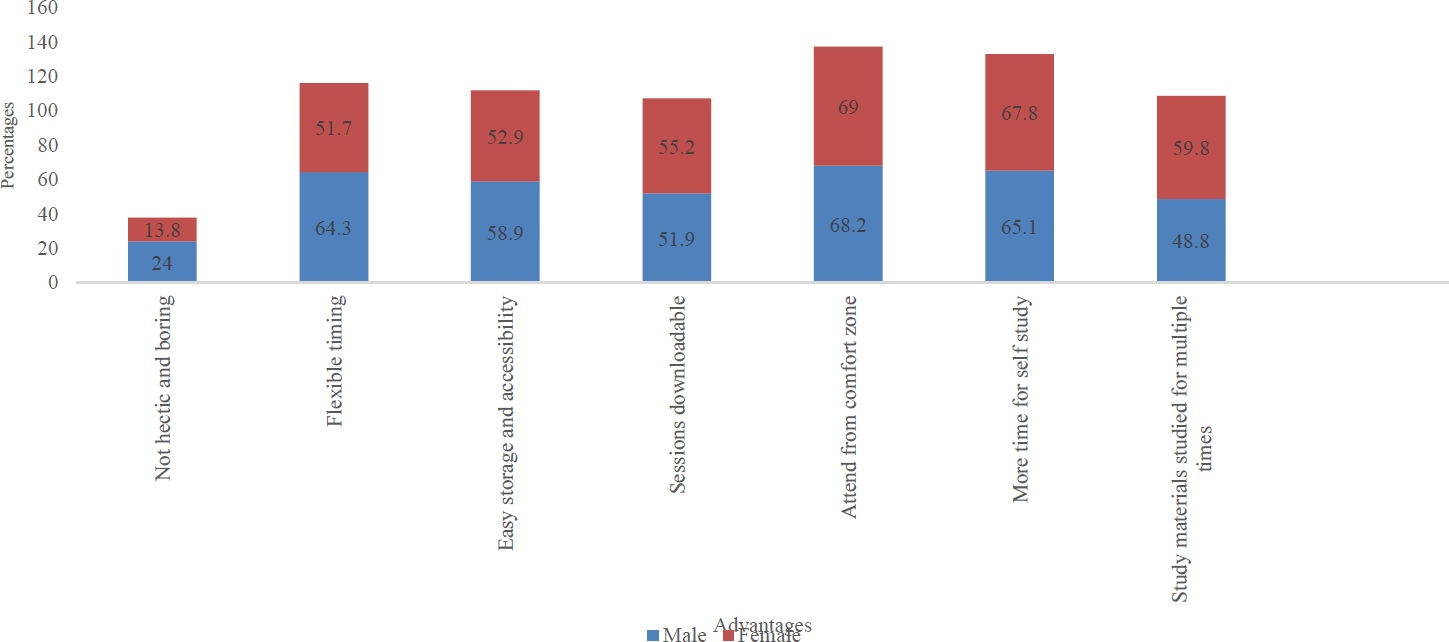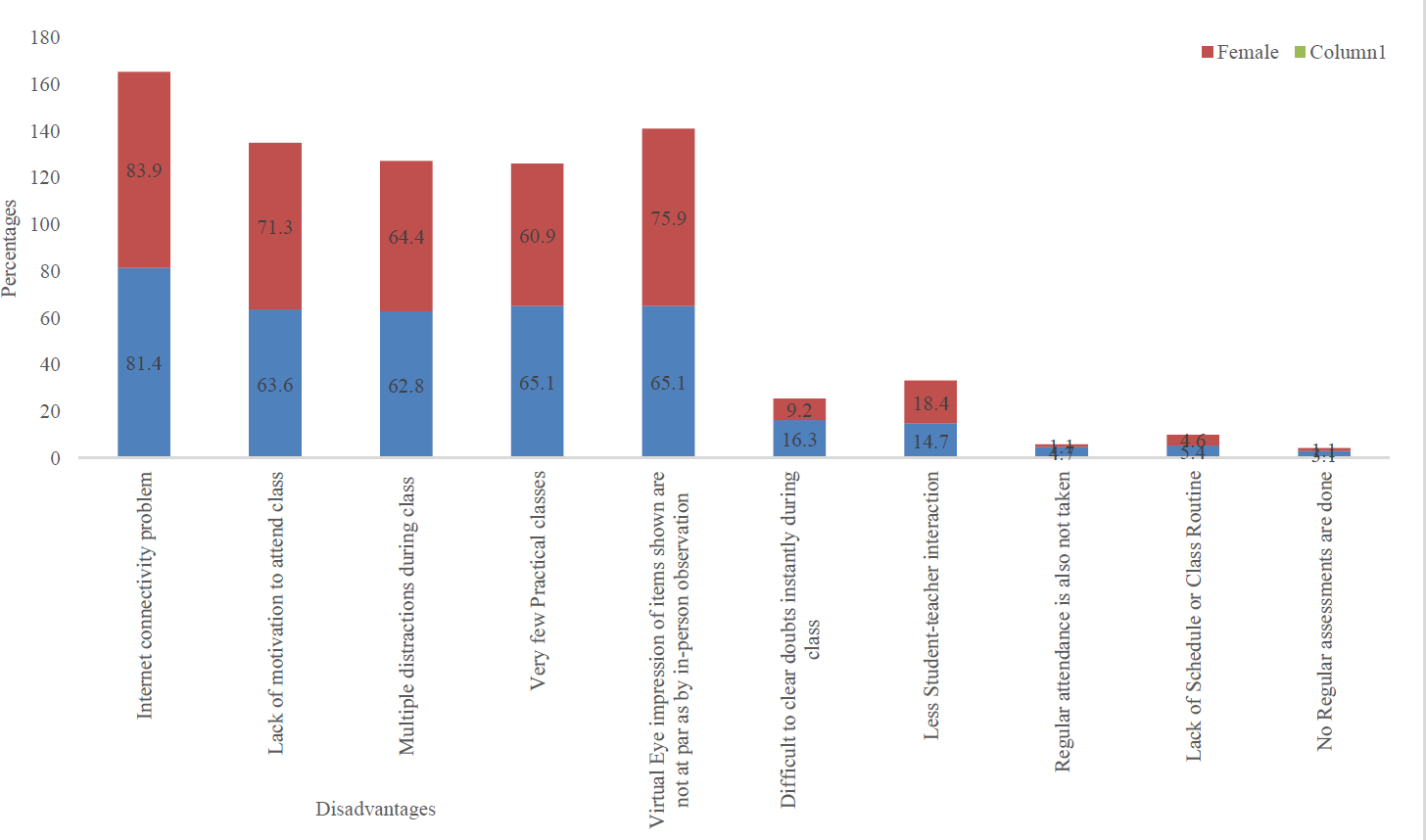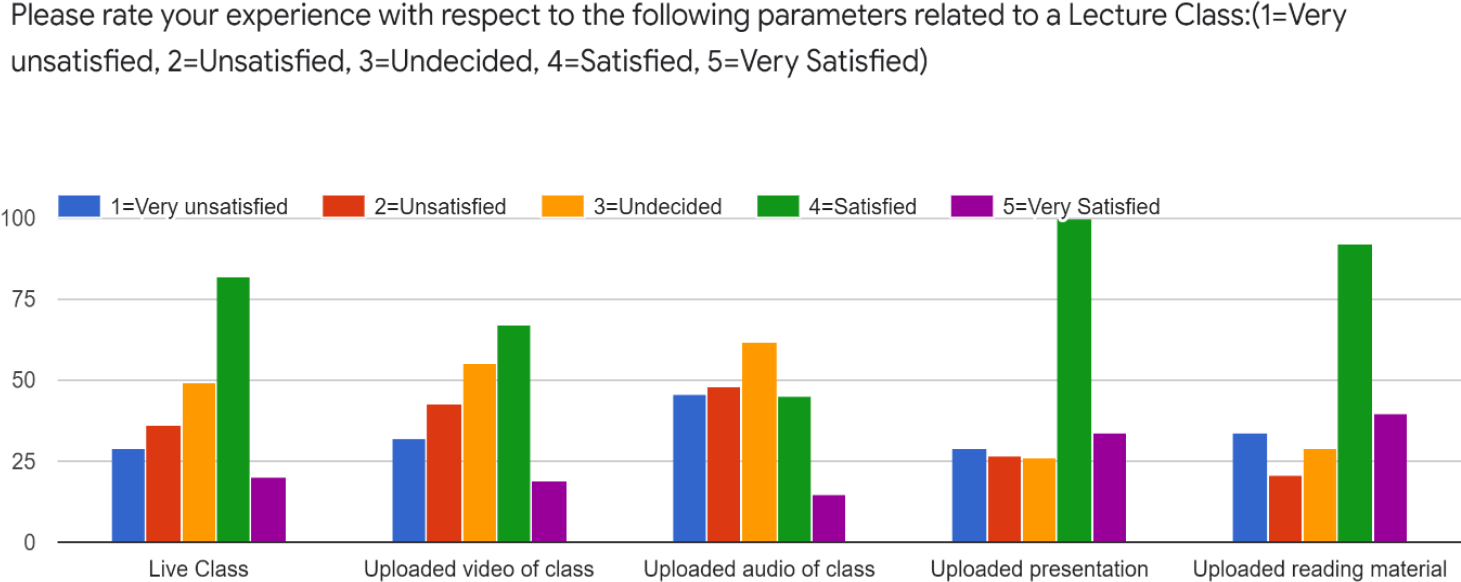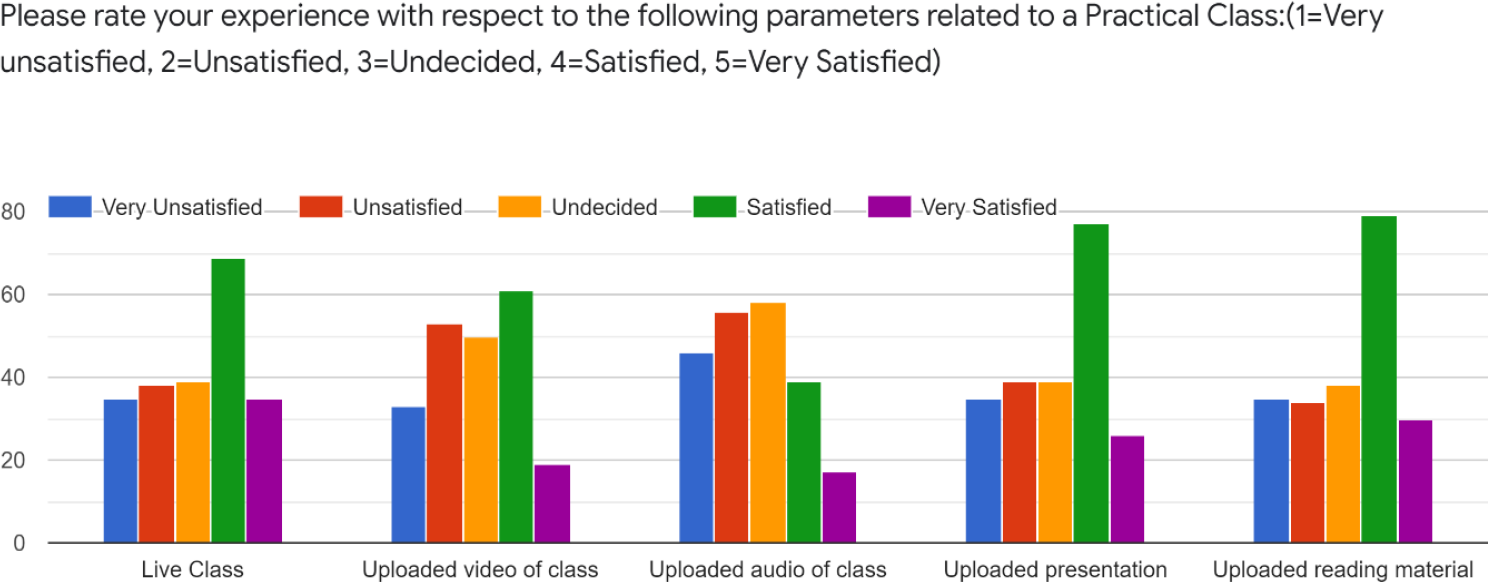Translate this page into:
Perception among undergraduate medical students about online teaching in a government medical college of West Bengal
CORRESPONDING AUTHOR: Dr Archita Bhattacharya, 25/1, Kasundia Road, Howrah, Pin-711101 E Mail ID: archita.bhattacharya.ab@gmail.com
-
Received: ,
Accepted: ,
CITATION: Basu R, Roy SS, Dey A, Bhattacharya A, Hasan T, Das M. Perception among undergraduate medical students about online teaching in a government medical college of West Bengal. J Comp Health. 2022;10(2):52-59. Doi: https://doi.org/10.53553/JCH.v10i02.002
Abstract
Background-
COVID 19 pandemic had disrupted the traditional method of face-to-face learning and paved the way for online learning. Students’ and teachers’ perspective are important for further improve the quality of online learning.
Objective-
To study the perception of online teaching by the undergraduate medical students.
Materials and method-
The study was conducted on 216 undergraduate medical students of a medical college in Kolkata over a period of 2 months. All the students who completed the predesigned and pretested questionnaire administered through google forms were included in the study. The analysis was done in SPSS version 22.
Results-
The mean age of the study participants was 20.8 years. Majority of the participants used mobile phones for attending classes and WhatsApp for coordinating online classes and uploading live classes. Most of the participants perceived online class for lecture classes and face-to-face class for practical classes. There is statistical association between mode of interaction with faculty and sex (P=0.000). The main advantages of online learning were attending from comfort zone, more time for self-study, flexible timing, not hectic and boring, easy storage and accessibility, downloadable sessions and study materials can be studied for multiple times.
Conclusion-
There is a need to train the teachers and the students about online platforms for improving the quality of teaching learning methods. Qualitative research may be done to fine out the core problems of the students to handle this new method of education.
Keywords
Covid 19
Perception
Students
Online Teaching
Google Forms
INTRODUCTION
COVID-19 pandemic had caused severe impact among all aspects of human life including medical education all over the world. With principles of social distancing and lockdown being enforced all face-to-face classes were suspended.[1] Hence, medical schools found alternative approach to teach the medical students. The current electronic learning (e-learning) was considered to be the core method of teaching curriculum during the COVID-19 pandemic.[2] The impact of information technology on human life and its role in education was worth mentioning. The contribution of information technology gained momentum due to closure of educational institutions raising challenges for students’ learning.[3] E-learning is defined as the use of information technology for improving the quality of education.[4] It combines distance learning with face-to-face teaching utilizing computer-mediated communication methods.[5] But e-learning like any other method of education has advantages and disadvantages for both students and teachers. Although e-learning and other approaches that combine online components into traditional classes continues to progress rapidly still remains to improve in due course. As students’ perception and attitude are important for motivation and learning developers and deliverers of online learning should have more understanding on students perception and reaction to e-learning and how to apply those approaches effectively to improve learning.[6] In this perspective the present study was planned with the aim to study the perception of online teaching by the undergraduate medical students.
MATERIAL & METHODS
This is a descriptive study with cross-sectional design. The study was conducted on all professional MBBS students of age 18 years to 30 years of a Medical College in Kolkata for a duration of two months (August -September 2021). Study tool consisted of five sections prepared after thorough literature review. The first section had questions on the background characteristics of the students, the second section had questions on technological aspect of online learning followed by third section on medium of instruction, fourth section on advantages and disadvantages of online learning and last section on assessment via online platforms. Pretesting of the questionnaire was done by discussing with experts and necessary changes were made. Utmost care was taken to make the language as simple as possible for the respondents to avoid any ambiguity. Data was collected by administering the questionnaire through the online google forms. The google form was created with a consent form attached to it and was shared through WhatsApp. Participants were required to give their consent before proceeding to the subsequent sections. Among all the students those who submitted completely answered questionnaire were included. Students unwilling to participate were excluded. A total of 216 students participated in the study. Data were entered into Microsoft excel and SPSS version 22 was used for analysis. Frequency distribution and percentage was calculated for categorical variables while mean and standard deviation was calculated for continuous variables with normal distribution and median and inter quartile range in case of non-normal distribution. Bar diagrams were used for pictorial representation of data. Ethical clearance was obtained from the Institutional Ethics Committee (Ref. No. RKC/533 dated 16-11-2021)
RESULTS
Sociodemographic characteristics (Table 1)
The demographic variables were sex, age, professional, place of residence, medium of education in higher secondary and stay in normal situation. The mean age of the study participants was 20.8 years. There were more male participants (61.6%) than female. Nearly half (42.6%) of the study participants belonged to First Professional MBBS and majority (73.6%) were from urban area. Among the study participants 61.6% had English as the medium of education in higher secondary.
| Variables | Frequency | Percentage |
|---|---|---|
| Sex | ||
| Male | 133 | 61.6 |
| Female | 83 | 38.4 |
| Age | ||
| 18-20 | 33 | 15.3 |
| 20-22 | 130 | 60.2 |
| >22 | 53 | 24.5 |
| Professional | ||
| First Professional MBBS | 92 | 42.6 |
| Second Professional MBBS | 78 | 36.1 |
| Third Professional MBBS | 44 | 20.4 |
| Fourth Professional MBBS | 2 | 0.9 |
| Place of residence | ||
| Rural | 57 | 26.4 |
| Urban | 159 | 73.6 |
| Medium of education in higher secondary | ||
| English | 132 | 61.6 |
| Bengali | 82 | 38 |
| Hindi | 2 | 0.9 |
| Stay in normal situation | ||
| Home | 3 | 1.4 |
| Hostel | 84 | 38.9 |
| Others | 129 | 59.7 |
Perception on technological aspect of online teaching (Supplementary Table 2)
Majority of male participants (95.3%) and female participants (97.7%) used mobile phones for attending online classes. Speaker is used for audio by 83.9% males and 22.5% of females used headphones for audio. Among the males 52.7% used Microsoft team for attending online class and 62.5% females used Google meet for the same. Majority of the participants used Whatsapp for coordinating online classes and uploading live classes. Most of the participants used mobile data as the source of internet.
Media of instruction for online class (Supplementary Figure 1)
For lecture class most of the participants (94%) responded as uploaded presentation as the media of instruction followed by uploaded reading material (91.7%) and uploaded audio of class (85.2%). For practical class 69% responded live class with interaction, 55.6% responded live class only and 55.1% uploaded video of class as the media of instruction.
Perception according to mode of class and assessment methods via online platform (Table 2)
In lecture class for understanding of content most of the participants (77.5% male and 82.8% female) responded face to face as the mode of class. Almost 66.7% of the males and 75.9% of the females responded face to face mode had less distraction during lecture class. More than half of the participants responded virtual mode for recording of information, flexibility of timings, flexibility of continuation of class and face to face for interaction with faculty, interaction with peers and clearing of doubts. Face to face class for practical classes was marked for understanding of content (91.5% male and 90.8% female), distraction during class (79.8% male and 86.2% female), recording of information (69.8% male and 66.7% female), flexibility of class timing (59.7% male and 54% female), flexibility of continuation of class (68.2% male and 60.9% female), interaction with faculty (89.1% male and 95.4% female), interaction with peers (89.9% male and 94.3% female) and clearing of doubts (90.7% male and 93.1% female). There is statistical association between mode of interaction with faculty and sex (P=0.000). Among the participants 65.1% males and 64.4% females responded assessment of theory by MCQ and assessment of practical by offline or face to face mode by 25.6% of males and 23% females. Majority of the participants (90.7% males and 89.7% females) said circulation of assessment was done using Whatsapp and more than half of the participants responded submission of assessment was done via Whatsapp. There was statistical association between method for submission of assessment and sex. Frequency of assignments at interval of months was responded by 44.2% males and 36.8% females. More than half of the participants (62% males and 57.5% females) responded no information on performance in the assessments were given. More than half of the participant said feedback was given via Whatsapp.
| Type of class | Parameters related to mode of class | Male | Female | P value |
|---|---|---|---|---|
| Lecture class | Understanding of content | |||
| Face to face | 100(77.5) | 72(82.8) | 0.348 | |
| virtual | 29(22.5) | 15(17.2) | ||
| Less distraction during class | ||||
| Face to face | 86(66.7) | 66(75.9) | 0.147 | |
| Virtual | 43(33.3) | 21(24.1) | ||
| Recording of information | ||||
| Face to face | 57(44.2) | 34(39.1) | 0.456 | |
| virtual | 72(55.8) | 53(60.9) | ||
| Flexibility of class timing | ||||
| Face to face | 49(38) | 34(39.1) | 0.870 | |
| virtual | 80(62) | 53(60.9) | ||
| Flexibility of continuation of class | ||||
| Face to face | 60(46.5) | 42(48.3) | 0.798 | |
| virtual | 69(53.5) | 45(51.7) | ||
| Interaction with Faculty | ||||
| Face to face | 105(81.4) | 77(88.5) | 0.159 | |
| virtual | 24(18.6) | 10(11.5) | ||
| Interaction with peers | ||||
| Face to face | 109(84.5) | 78(89.7) | 0.275 | |
| virtual | 20(15.5) | 9(10.3) | ||
| Clearing of doubts | ||||
| Face to face | 101(78.3) | 73(83.9) | 0.307 | |
| virtual | 28(21.7) | 14(16.1) | ||
| Practical class | Understanding of content | |||
| Face to face | 118(91.5) | 79(90.8) | 0.865 | |
| virtual | 11(8.5) | 8(9.2) | ||
| Distraction during class | ||||
| Face to face | 103(79.8) | 75(86.2) | 0.228 | |
| virtual | 26(20.2) | 12(13.8) | ||
| Recording of information | ||||
| Face to face | 90(69.8) | 58(66.7) | 0.571 | |
| virtual | 39(30.2) | 29(33.3) | ||
| Flexibility of class timing | ||||
| Face to face | 77(59.7) | 47(54) | 0.409 | |
| virtual | 52(40.3) | 40(46) | ||
| Flexibility of continuation of class | ||||
| Face to face | 88(68.2) | 53(60.9) | 0.269 | |
| virtual | 41(31.8) | 34(39.1) | ||
| Interaction with Faculty | ||||
| Face to face | 115(89.1) | 4(95.4) | 0.000 | |
| virtual | 14(10.9) | 83(4.6) | ||
| Interaction with peers | ||||
| Face to face | 116(89.9) | 82(94.3) | 0.259 | |
| virtual | 13(10.1) | 5(5.7) | ||
| Clearing of doubts | ||||
| Face to face | 117(90.7) | 81(93.1) | 0.530 | |
| virtual | 12(9.3) | 6(6.9) | ||
| Assessment via online platforms | ||||
| Theory | MCQ | 84(65.1) | 56(64.4) | |
| Short answer | 65(50.4) | 40(46.0) | 0.734 | |
| Long answer | 37(28.7) | 32(36.8) | ||
| Viva | 49(38) | 28(32.2) | ||
| Combination of the above | 48(37.2) | 28(32.2) | ||
| Practical | MCQ | 20(15.5) | 13(14.9) | |
| Viva | 13(10.1) | 9(10.3) | 0.989 | |
| Offline or face to face | 33(25.6) | 20(23) | ||
| Others | 24(18.6) | 14(16.1) | ||
| Circulation of assessment | 117(90.7) | 78(89.7) | ||
| Google classroom | 19(14.7) | 17(19.5) | 0.555 | |
| Google form | 3(2.3) | 5(5.7) | ||
| Microsoft team | 2(1.6) | 2(2.3) | ||
| Gmail | 18(14.0) | 18(20.7) | ||
| Submission of assessment | Google classroom | 21(16.3) | 14(16.1) | |
| 79(61.2) | 48(55.2) | 0.000 | ||
| 26(20.2) | 29(33.3) | |||
| Microsoft team | 3(2.4) | 18(26) | ||
| Frequency of assignments | Irregular | 8(6.2) | 9(10.3) | |
| Interval of months | 57(44.2) | 32(36.8) | 0.572 | |
| Interval of weeks | 51(39.6) | 37(42.5) | ||
| After each class | 5(3.9) | 4(4.6) | ||
| Information on performance in the assessments given | Yes | 49(38) | 37(42.5) | 0.503 |
| No | 80(62) | 50(57.5) | ||
| Feedback given by | Google classroom | 13(10.1) | 6(6.9) | |
| 76(58.9) | 61(70.1) | 0.425 | ||
| 14(10.9) | 10(11.5) | |||
| Others | 5(3.9) | 1(1.1) | ||
Perception on advantages and disadvantages of online learning (Figure 1, Figure 2)

- BAR DIAGRAM SHOWING STUDENTS’ PERCEPTION ON ADVANTAGES OF ONLINE LEARNING. (N=216)

- BAR DIAGRAM SHOWING STUDENTS’ PERCEPTION ON DISADVANTAGES OF ONLINE LEARNING. (N=216)
Online class can be attended from comfort zone was mentioned by 68.2% males and 69% females, more time for self-study responded by 65.1% males and 67.8% females and flexible timing by 64.3% males and 51.7% females. Other advantages mentioned were not hectic and boring, easy storage and accessibility, downloadable sessions and study materials can be studied for multiple times. Internet connectivity problem was mentioned as a disadvantage by 81.4% males and 83.9% females followed by lack of motivation to attend class by 63.6% males and 71.3% females and virtual eye impression of items shown were not at par as by in-person observation by 65.1% males and 75.9% females. Other disadvantages include multiple distractions during class, very few practical classes, difficult to clear doubts instantly, less student teacher interaction, no regular attendance, lack of routine or scheduled class and lack of regular attendance.
Experience with respect to the parameters related to lecture class and practical class (Figure 3, Figure 4)

- BAR DIAGRAM SHOWING EXPERIENCE WITH RESPECT TO THE PARAMETERS RELATED TO LECTURE CLASS. (N=216)

- BAR DIAGRAM SHOWING EXPERIENCE WITH RESPECT TO THE PARAMETERS RELATED TO PRACTICAL CLASS. (N=216)
For lecture class 38% of the students were satisfied and 9.2% were very satisfied in live class, 31% were satisfied ad 8.7% were very satisfied for uploaded video of class, 20.8% were satisfied and 6.9% were very satisfied for uploaded audio of class, 46.2% were satisfied and 15.7% were very satisfied for uploaded presentation and 42.6% were satisfied and 18.5% were very satisfied for uploaded reading material. In case of practical class 31.9% were satisfied and 14.2% were very satisfied in live class, only 28.2% were satisfied and 8.7% were very satisfied with uploaded video of class, 18% were satisfied and 7.9% were very satisfied with uploaded audio of class, 35.6% satisfied and 12% very satisfied with uploaded presentation and 36.6% were satisfied and 13.9% were very satisfied with uploaded reading material.
DISCUSSION
The present study assessed the perception of online teaching among undergraduate medical students using semi-structured google questionnaire. It focused on 216 medical students of a medical college in West Bengal. Majority of the participants used mobile phones for attending online classes. Smart phones were used as the main device for online classes in studies by Gismalla et al, Kaliisa et al and Felix Bast.[7-9] Applications like Microsoft team and google meet were preferred for the online classes and Whatsapp for coordinating online classes and uploading live classes whereas studies conducted by Shree et al and Punathukandi reported Zoom as the preferred application by the students.[10,11]. In the present study the University conducted online classes primarily through Microsoft team and google meet.
Most of the participants preferred online mode with uploaded reading material for lecture classes whereas for practical classes face to face class was preferred by more than half of the participants. A similar conclusion was reached by Shree et al, Abbasi et al and Akuratiya et al.[10,12,13]
In the present study most of the participants considered face to face learning to provide better understanding of content with less distraction during class and virtual mode for recording of information, flexibility of timings, flexibility of continuation of class and face to face for interaction with faculty, interaction with peers and clearing of doubts. There is statistical association between mode of interaction with faculty and sex. Similar observations were obtained by Shree et al, Punathukandi S et al, Abbasi et al and Sindiani et al.[10,11,12,14]
The main advantages of online learning were attending from comfort zone, more time for self-study, flexible timing, not hectic and boring, easy storage and accessibility, downloadable sessions and study materials can be studied for multiple times. Shree et al found that the students perceived hours saved in travelling, more time to study, and the convenience of accessing classes from home were some of the advantages. [10] Comparable findings were observed by Felix Bast, Sindiani et al and Dost et al. [7,14,15] However, internet connectivity problem, lack of motivation to attend class, multiple distractions during class, very few practical classes, difficult to clear doubts instantly, less student teacher interaction, no regular attendance, lack of routine or scheduled class and lack of regular attendance were mentioned as disadvantages to online learning. These disadvantages were in accordance with studies conducted by Thapa et al, Sawarkar et al and Deepika Nambair.[16-18] This could be due to the immediate social isolation imposed in the pandemic, resulting in low motivation levels and other psychological problems. On the other hand, studies conducted by showed E-learning improved student's motivation and concentration levels, better rate of assignment submissions than traditional teaching and higher convenience and student attendance.[19-21]
The limitation of the study was that it was conducted among medical students only and as the questionnaire of the study was distributed via WhatsApp students having internet connection could participate in the study.
CONCLUSION
In the present study the students although preferred online mode of learning for lecture classes traditional face-to-face methods were preferred for practical classes. The study also highlighted various disadvantages of online learning. There is also a need to train the teachers about online platforms for improving the quality of teaching learning methods. The students should also be motivated and trained about online learning. Additional research like qualitative research should be done to fine out the core problems of the students to handle this new method of education to further enhance the quality of online education.
REFERENCES
- Medical education during pandemics: a UK perspective. 2020. BMC Med. 18:100.
- [CrossRef] [PubMed] [Google Scholar]
- Students’ perception of online learning during the COVID-19 pandemic: A survey study of Polish medical students. 2021. Medicine (Baltimore). 19:e24821. 7
- [Google Scholar]
- Students’ Perception towards E-Learning during COVID-19 Pandemic in India: An Empirical Study. 2020. Sustainability. 23:57. 1
- [CrossRef] [Google Scholar]
- Integration of a Case-Based Online Module into an Undergraduate Curriculum: What is Involved and is it Effective? E-Learn Digit Media. 2009;6(4):372-84.
- [CrossRef] [Google Scholar]
- Students’ Perceptions towards the Quality of Online Education: A Qualitative Approach. . ;17
- [Google Scholar]
- Learners' Perceptions toward the Web-based Distance Learning Activities/Assignments Portion of an Undergraduate Hybrid Instructional Model. J Inf Technol Educ Res. 2003;2:105-13.
- [CrossRef] [Google Scholar]
- Perception of Online Learning Among Students From India Set Against the Pandemic. Front Educ. 2021;18(6):705013.
- [CrossRef] [Google Scholar]
- Medical students' perception towards E-learning during COVID 19 pandemic in a high burden developing country. 2021. BMC Med Educ. 21:377.
- [CrossRef] [PubMed] [Google Scholar]
- A Systematic Review on Mobile Learning in Higher Education: The African Perspective. Turk Online J Educ Technol. 2017;16(1):19.
- [Google Scholar]
- Perceptions of Undergraduate Medical Students towards Online Learning in a Medical College in the National Capital Region (NCR), India. Indian J Community Health. 2022;30(34):207-12. 2
- [CrossRef] [Google Scholar]
- Perception of medical students regarding E-learning during lockdown in COVID-19 pandemic: A cross-sectional study in a medical college, North Kerala. 2022. 34:227-33.
- [CrossRef] [Google Scholar]
- E-Learning perception and satisfaction among health sciences students amid the COVID-19 pandemic. Work. 2020;1(67):549-56. 3
- [CrossRef] [PubMed] [Google Scholar]
- Students' Perception of Online Learning during COVID-19 Pandemic: A Survey Study of IT Students. 2020. 1:755-8.
- [Google Scholar]
- Distance education during the COVID-19 outbreak: A cross-sectional study among medical students in North of Jordan. 2020. Ann Med Surg. 59:186-94.
- [CrossRef] [PubMed] [Google Scholar]
- Perceptions of medical students towards online teaching during the COVID-19 pandemic: a national cross-sectional survey of 2721 UK medical students. 2020. BMJ Open. 10:e042378.
- [CrossRef] [PubMed] [Google Scholar]
- Nursing students' attitude on the practice of e-learning: A cross-sectional survey amid COVID-19 in Nepal. PLOS ONE. 2021;24(16):e0253651. 6
- [CrossRef] [PubMed] [Google Scholar]
- Ayurveda students' perception toward online learning during the COVID-19 pandemic. 2020. J Educ Health Promot. 9:342.
- [CrossRef] [PubMed] [Google Scholar]
- The impact of online learning during COVID-19: students' and teachers' perspective. Int J Indian Psychol [Internet] 2020. 258 Available from: https://ijip.in/articles/the-impact-of-online-learning-during-covid-19-students-and-teachers-perspective/ (accessed )
- [Google Scholar]
- Critical success factors for e-learning in developing countries: A comparative analysis between ICT experts and faculty. Comput Educ. 2012;58(2):843-55.
- [CrossRef] [Google Scholar]
- Blended learning: how can we optimise undergraduate student engagement? | BMC Medical Education | Full Text [Internet] Available from: https://bmcmededuc.biomedcentral.com/articles/10.11 86/s12909-016-0716-z#citeas (accessed )
- [Google Scholar]
- Tracking e-learning through published papers: A systematic review. Comput Educ. 2019;136(1):87-98.
- [CrossRef] [Google Scholar]






